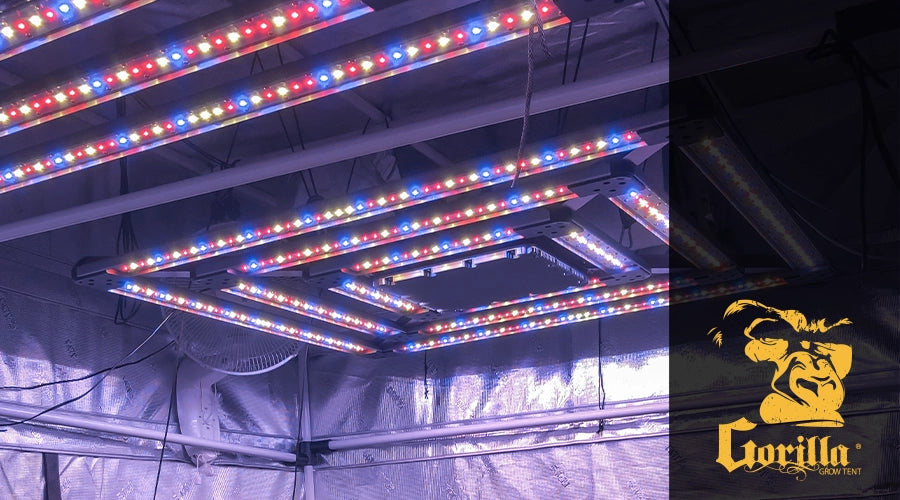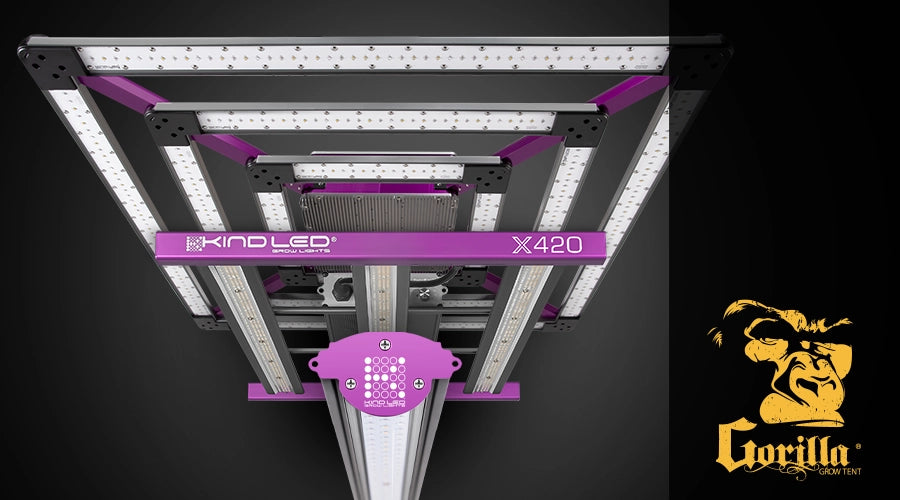
Maximizing Yield with Vegetative Spectrum LED Grow Lights
Choosing the Right Spectrum: LED Grow Light Spectrum Explained
What do LED grow lights do?
There is a simple answer to this! These lamps are a light source specially designed for plants with a specific radiation spectrum, which helps plants to develop, bloom and bear fruit normally.
LED grow lights are artificial light sources used for growing plants indoors, and the light spectrum they emit is a crucial factor in their effectiveness. The light spectrum that plants use for photosynthesis mostly consists of blue and red light.
The wavelength of blue light is about 400-500nm and is important for vegetative growth, including the development of leaves and stems. The wavelength of red light is about 600-700nm and is important for flowering and fruiting.
Most LED grow lights will have a combination of blue and red diodes in varying proportions depending on the intended use. Some LED grow lights may also include other wavelengths of light, such as green or yellow, which may be useful for monitoring plant health or just for aesthetics.
When it comes to the light spectrum, it's important to keep in mind that different plant species may have different requirements. Not every plant needs the same kind of light. For example, leafy greens such as lettuce or spinach may benefit from higher levels of blue light, while fruiting plants such as tomatoes may need more red light.
To maximize yields with vegetable spectrum LED grow lights, you should consider the following:
Optimizing Yield with Vegetative Spectrum LED Grow Lights
Choose the right spectrum:
LED grow lights come in different spectrums, including full spectrum, red-blue spectrum, and vegetable spectrum. The vegetable spectrum is ideal for growing vegetables as it provides the right wavelengths of light that plants need for optimum growth and yield.
Determine the correct density:
The intensity of light required varies with the type of vegetable you are growing. Some vegetables require higher light intensity than others. Therefore, you should make sure that the intensity of your LED grow light is appropriate for the type of vegetable you are growing.
Determine the correct time:
The amount of light required also varies with the type of vegetable you are growing. Some vegetables require longer light than others. Therefore, you should make sure that the duration of your LED grow light is appropriate for the type of vegetable you are growing.
Keep the right distance:
The distance between the LED grow light and the plants should be appropriate so as not to burn the plants or provide insufficient light. You should follow the manufacturer's recommendations for the correct distance between the LED grow light and the plants.
Provide proper ventilation:
Plants need fresh air to grow at their best. Therefore, you should make sure that your grow room has proper ventilation to provide your plants with fresh air.
Monitoring and tuning:
You should regularly monitor the growth of your plants and adjust the intensity, duration, and distance of the LED grow light accordingly.
Provide the right nutrients:
Plants need the right nutrients to grow at their best. Therefore, you must provide your plants with the right nutrients, including fertilizers, minerals, and water.
Illuminating Growth: Understanding the Benefits of Full Spectrum LED Grow Lights in Grow Tents
When it comes to indoor gardening, providing the right light spectrum is crucial for the healthy growth and development of plants. Full spectrum LED grow lights have revolutionized the industry by providing a comprehensive range of light wavelengths that closely mimic natural sunlight. In this article, we'll explore the benefits of using full spectrum LED grow lights in grow tents and how they contribute to maximizing yields and promoting optimal plant growth.
The Full Spectrum Advantage: Maximizing Plant Growth with LED Grow Lights in Grow Tents
Mimicking Natural Sunlight:
Full spectrum LED grow lights are designed to emit a balanced spectrum of light that closely resembles the natural sunlight plants receive outdoors. Unlike traditional grow lights that may only provide specific wavelengths, full spectrum LEDs encompass the entire range of light from the ultraviolet (UV) to infrared (IR), including red, blue, green, and white wavelengths. This mimicking of natural sunlight allows plants to photosynthesize more efficiently, leading to healthier and more productive growth.
Customizable Light Spectrum:
One of the significant advantages of full spectrum LED grow lights is their customizable light spectrum. Advanced models offer adjustable spectrums, allowing growers to tailor the light output to suit specific plant growth stages. By adjusting the intensity of different wavelengths, growers can optimize light for seedlings, vegetative growth, flowering, or fruiting stages. This flexibility ensures that plants receive the most appropriate light spectrum at each stage, promoting optimal development and maximizing yields.
Energy Efficiency and Cost Savings:
Compared to traditional lighting technologies like high-pressure sodium (HPS) or metal halide (MH) lamps, full spectrum LED grow lights are highly energy-efficient. They convert a higher percentage of energy into usable light while producing less heat. This efficiency translates into significant energy savings over time and lowers electricity costs for growers. LED lights also have a longer lifespan, reducing the need for frequent bulb replacements and further contributing to cost savings.
Low Heat Emission:
Full spectrum LED grow lights emit significantly less heat compared to conventional lighting options. Excessive heat can damage plants or require additional cooling systems to maintain an ideal temperature in the grow tent. LED lights produce minimal heat, reducing the risk of heat stress or burns to plant foliage. This allows growers to position the lights closer to the canopy without risking damage, maximizing light intensity and ensuring uniform light distribution.
Increased Light Penetration:
Full spectrum LED grow lights emit focused light with high light intensity, allowing for better light penetration into the plant canopy. The directional light output ensures that more light reaches the lower foliage and side branches, promoting even growth and reducing the occurrence of shaded areas. This increased light penetration helps to develop strong and healthy plants from top to bottom, leading to higher yields and more robust harvests.
Reduced Environmental Footprint:
LED grow lights are known for their eco-friendly attributes. They consume less electricity, contributing to lower carbon emissions and reducing the environmental impact of indoor gardening. Additionally, full spectrum LED lights do not contain hazardous substances like mercury, which are commonly found in other lighting technologies. This makes them easier to dispose of and ensures a safer and cleaner growing environment.
Enhanced Plant Growth and Development:
Full spectrum LED grow lights provide the ideal light spectrum required for all stages of plant growth. The balanced combination of red, blue, and other wavelengths promotes robust vegetative growth, encourages flowering, and supports the development of healthy fruits or flowers. By providing plants with the right light spectrum, full spectrum LED grow lights contribute to overall plant vigor, increased biomass, and improved quality of the harvest.
Low Heat Signature for Better Climate Control:
The low heat emission of full spectrum LED grow lights simplifies climate control in the grow tent. With less heat generated, growers have better control over the ambient temperature, humidity, and ventilation. This enables them to create an optimal environment for plant growth without relying on excessive cooling systems, saving energy and reducing the risk of heat-related stress or damage to the plants.
Reduced Risk of Plant Diseases and Pests:
Full spectrum LED grow lights emit less heat and UV radiation, which can help reduce the risk of plant diseases and pest infestations. High temperatures and excessive UV exposure can create favorable conditions for mold, fungi, and pests to thrive. By using LED grow lights, growers can maintain a healthier growing environment, minimizing the chances of encountering common issues that can hinder plant growth and productivity.
Greater Control and Precision:
Full spectrum LED grow lights often come with advanced control systems that allow growers to fine-tune the light intensity and spectrum. This level of control enables precise adjustments to meet the specific needs of different plant species or growth stages. By customizing the lighting parameters, growers can optimize plant responses, increase efficiency, and achieve consistent results across multiple harvests.
Versatility and Adaptability:
Full spectrum LED grow lights are versatile and can be used for various indoor gardening setups, including grow tents of different sizes. They can be mounted overhead, along the sides, or at different heights to suit the specific needs of the plants. LED lights also have a compact and lightweight design, making them easy to install and reposition as needed.
Longevity and Reliability:
LED technology has a longer lifespan compared to traditional lighting options. Full spectrum LED grow lights can last for tens of thousands of hours, providing growers with long-term lighting solutions. Their durability and resistance to shock or vibrations make them ideal for grow tent environments where movement or accidental bumps may occur.
Full spectrum LED grow lights offer a wide range of benefits for indoor gardeners using grow tents. From promoting healthy plant growth and development to providing energy-efficient lighting solutions, these lights deliver superior performance and versatility. With their customizable light spectrum, low heat emission, enhanced control, and long lifespan, full spectrum LED grow lights are becoming the go-to choice for growers seeking optimal results and sustainable cultivation in their grow tents. Embrace the power of full spectrum LED grow lights, and watch your plants thrive in a well-lit, efficient, and productive indoor garden.


